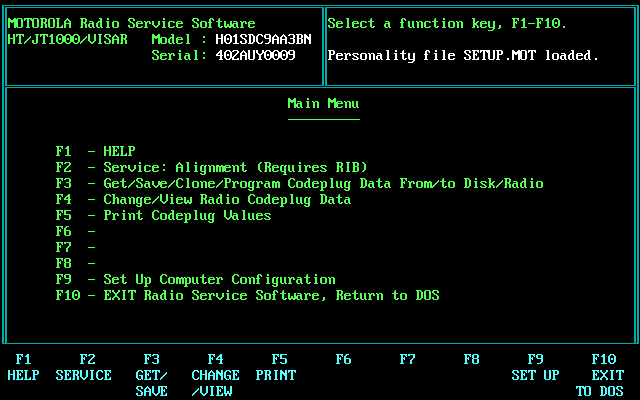Motorola Portables
General information on programing (mostly), reparing (not so much) and using Motorola portable radios.
Programing
Most
older Motorola portable radios are programed with a ugly piece of
software called RSS, or Radio Service Software. RSS is MS-DOS based and
with a few notable exceptions, only runs on anchient Intel 286, 386 or
486 based machines and their clones. Each model radio has a different
version of RSS specifically for that model. It's VERY important to
realize how unforgiving RSS is to any errors or incongruities. A small
break in a RIB connector cord or a momentary power loss can brick a
radio permenatly.
DON'TS:
- Use a "DOS window" in an older version of Microsoft Windows. Like 95 or 98SE.
- Use any machine newer than a 486.
- Use any programing cables that you think even MIGHT be damaged.
- Dump/Flash
the codeplug excessivley. If you only need to do it once, only do it
once. Flashing codeplugs is black magic, and they corrupt rather easily.
- Use true MS-DOS or a custom bootdisk with MS-DOS or DOS based Windows (Free-DOS works in some cases.
- Make
sure that the radio's battery is fully charged and won't lose power
during the programing. (Attaching the radio to a charger is good idea.)
- Make sure that the PC is hooked up to a good UPC or use a laptop with a good batery and connect it to a PSU.
- MAKE
A BACKUP OF THE ORIGINAL CODEPLUG. (This is SO important. If you
"brick" your radio, it might be recoverable. You just need that
original codeplug.)
- Plan
out EXACTLY what you want to program ahead of time. So you aren't stuck
figuring out what you want while the radio is connected.
RSS
is rather picky. The program times itself (and the serial
communication) by the processor speed. Even an old Pentium II or I
shouldn't be able to program a radio correctlly. (The progam ends up
sending data to the radio faster than the serial connection can handle
the data, and corrupts the codeplug.) But the VISAR RSS (HT1000, JT1000
and Visar) has been demonstrated to work on a bootdisk configuration on
a Pentium 4. There are alot of variables, and I DO NOT recomend trying
this, but the VISAR RSS is much less picky about what computers it will
run correctly on. If you want to try this, here was my setup: HP Compaq
desktop computer with a COM port, RIBless programing cable from eBay,
and a VISAR RSS version 03.02.01 bootdisk running MS-DOS 6.22. Please
read see my disclaimer page if you choose to continue with this.
DOSBox
Some
people have reported success programing MAXTRAC and JEDI series radios
on much newer hardware and operating systems using DOSBox and either a
native COM port or a FTDI USB to serial converter cable. (This is very
version dependant and will only work with DOSBox v0.65 which can be
downloaded here) By
default, DOSBox disables emulated COM ports, to enable the COM port in
DOSBox, you need to edit the 'dosbox.conf' file with the folowing text
(look around the end of the config file for the serial settings)
serial1=directserial realport:COM1 ocbus
serial2=directserial realport:COM2 ocbus
serial3=disabled
serial4=disabled
This
will set the emulated COM1 and COM2 ports in DOSBox as the physical COM
1 and 2 ports. (If you are using a USB to serial converter you may need
to change the assigned COM port to the device in Device Manager)
Hopefully this should work perfectly, to get around the emulated processor speed problems use the CTRL-F11 to slow it down.
Motorola JEDI RSS screenshot runing in DOSBox v0.65
"Lab" or "Depot" RSS.
Aside
from the "normal" RSS that you and everyone else uses, there are also
versions of RSS for each radio that are for Motorola internal use and
have an elevated featureset and can hex edit the codeplug. These
versions are good for making a comprehensive codeplug backup as it
backs up more information than "normal" RSS does. Other things you can
change include the customer ID, codeplug versiom, serial and model
numbers.

